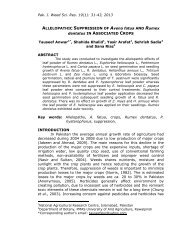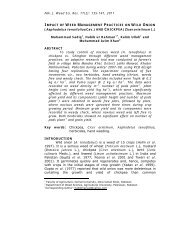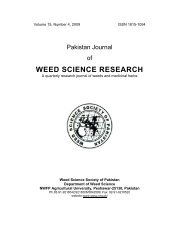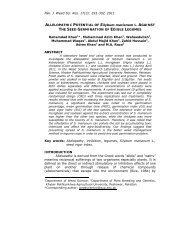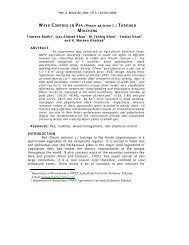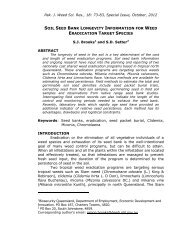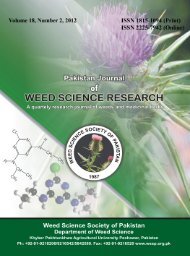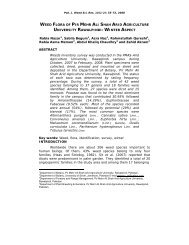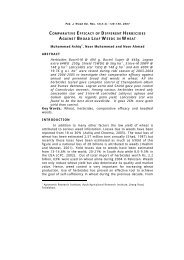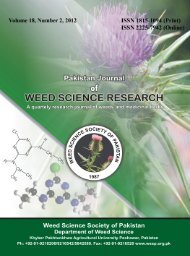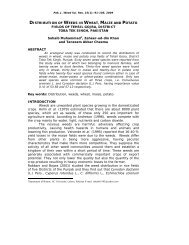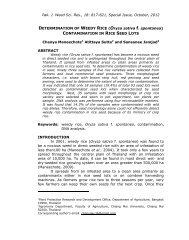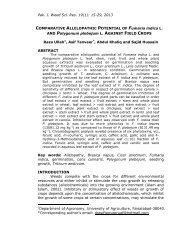propyrisulfuron, a new sulfonylurea herbicide for rice - Wssp.org.pk
propyrisulfuron, a new sulfonylurea herbicide for rice - Wssp.org.pk
propyrisulfuron, a new sulfonylurea herbicide for rice - Wssp.org.pk
Create successful ePaper yourself
Turn your PDF publications into a flip-book with our unique Google optimized e-Paper software.
Pak. J. Weed Sci. Res., 18: 229-237, Special Issue, October, 2012PROPYRISULFURON, A NEW SULFONYLUREA HERBICIDE FORRICEHajime Ikeda 1 , Junko Inaba 1 , Yukari Kajiwara 1 and YasushiTanakaABSTRACTPropyrisulfuron, 1 - (2 - chloro - 6 - propylimidazo [1, 2 - b]pyridazin - 3 - ylsulfonyl) - 3 - (4, 6 - dimethoxypyrimidin - 2 - yl) ureais a <strong>new</strong> <strong>herbicide</strong> <strong>for</strong> use in paddy <strong>rice</strong>, which has been developed bySumitomo Chemical Co., Ltd. Results of pot tests in greenhouse studiesindicated that <strong>propyrisulfuron</strong> at 25 - 100 g a.i./ha af<strong>for</strong>ded excellentcontrol of annual and perennial paddy weeds, including Echinochloa spp.,sedges and broadleaf weeds. Application of <strong>propyrisulfuron</strong> at 27 - 55 ga.i./ha by spraying, followed by flooding, reduced the shoot biomass ofEchinochloa oryzicola at 3 - 5-leaf stage to under 10% of the untreatedcontrol. Propyrisulfuron was absorbed by both shoots and roots ofEchinochloa oryzicola, however, the contribution of the herbicidal activityof root absorbed Propyrisulfuron was estimated be more important thanshoot absorbed <strong>herbicide</strong>. Rice showed good tolerance to <strong>propyrisulfuron</strong>at 200 g a.i./ha.Key words: Propyrisulfuron, <strong>herbicide</strong>, paddy <strong>rice</strong>, paddy weedINTRODUCTIONPropyrisulfuron (Figure-1 and Table-1) is a <strong>new</strong> <strong>sulfonylurea</strong><strong>herbicide</strong> that has a fused heterocyclic moiety (Yamato et al., 2010,Ikeda et al., 2010, Ikeda et al., 2011), and was commercialized inJapan, 2010. The granular <strong>for</strong>mulation, suspension concentrate<strong>for</strong>mulation and ‘Jumbo’ <strong>for</strong>mulation (granules packed in water-solublefilm) are available <strong>for</strong> paddy <strong>rice</strong> as a brand name of Zeta-One R . Thispaper reports the properties of Propyrisulfuron, such as herbicidalactivity and safety to <strong>rice</strong>.n-C 3 H 7N N NClH HN N N OCHS3O O O NOCH 3Figure 1. The chemical structure of Propyrisulfuron.1 1Health & Crop Sciences Research Laboratory, Sumitomo Chemical Co., Ltd.,Takarazuka, Hyogo 665-8555, Japan1 Development and Manufacturing Division, Yashima Sangyo Co., Ltd., TokyoCorresponding author’s email: ikedah7@sc.sumitomo-chem.co.jp
230 Hajime Ikeda et al., Propyrisulfuron, a <strong>new</strong> Sulfonylurea…Table-1. Properties of Propyrisulfuron.Chemical and PhysicochemicalAppearance : White solidMelting point : >193.5 ºCWater solubility : 0.98 mg/L (20 ºC)Partition coefficient : Log Pow 2.9 (25 ºC)Acid dissociation constant : pKa 4.89 (20 ºC)ToxicologicalAcute oral : LD 50 > 2000 mg/kg, rat ♂Acute dermal : LD 50 > 2000 mg/kg, rat ♂♀Acute inhalation : LC 50 > 4300 mg/m 3 , rat ♂♀Skin irritation : Not irritant, rabbitEye irritation : Slightly irritant, rabbitMutagenicity : Negative (Ames test)Common carp : NOEC (96 hrs) >10 mg/LMATERIALS AND METHODSHerbicideThe <strong>herbicide</strong>s used <strong>for</strong> testing were 0.5 g/L provisionalemulsions or 100 g/L suspension concentrate. The provisionalemulsions were prepared by dissolving the technical grade of<strong>propyrisulfuron</strong> in acetone including 20 g/L sorbitan monolaurate(TWEEN TM 20; Sigma, St Louis, USA), or in N, N-dimethyl<strong>for</strong>mamideincluding the 20 g/L sorbitan monolaurate.Weed controlPot tests were conducted in a greenhouse using 200 cm 2 × 19cm plastic pots or 100 cm 2 × 14 cm plastic pots filled with light claysoil (pH 6.1 - 6.5, <strong>org</strong>anic matter 2.0 - 2.3 %) or sandy soil (pH 5.5,<strong>org</strong>anic matter 1.9 %). After the soil was puddled and flooded, the
Pak. J. Weed Sci. Res., 18: 229-237, Special Issue, October, 2012 231seeds or tubers of weeds shown in Figure 3, Figure 4 and Figure 5were planted in the pots. The weeds were grown in a greenhouse up tothe leaf stages indicated in Figure 3, Figure 4 and Figure 5.For submerged application tests, <strong>propyrisulfuron</strong> at 25 - 100 g a.i./hawas applied directly into standing water. The flooding depth was keptin 3 - 5 cm during experiments. The weed control efficacy wasevaluated at 3 - 5 weeks after the application, using a visual ratingscale of 0 (no effect) to 100 (completely killed) compared to anuntreated control. Each test was conducted with three replications.For spray application tests, <strong>propyrisulfuron</strong> at 50 and 100 ga.i./ha was sprayed over the top of plants. The volume rate was 500L/ha. There was no flooding water at the application. Pots were floodedto 2 - 5 cm above the soil surface at 2 - 4 days after the application.The weed control efficacy was evaluated at three weeks after theapplication, using a visual rating scale of 0 (no effect) to 100(completely killed) compared to an untreated control. Each test wasconducted with two replications.Dose responses of Echinochloa oryzicola at different growthstages to <strong>propyrisulfuron</strong> by spray application were investigated.Propyrisulfuron at 7 - 55 g a.i./ha was sprayed over the top of plants.The volume rate was 154 L/ha. There was no flooding water at theapplication. Pots were flooded to 5 cm above the soil surface at a dayafter the application. The shoot biomass (dry weight) was evaluated atfour weeks after the application. The test was conducted with tworeplication.ED 90 value, the dose giving 90 % reduction of shoot biomasscompared to an untreated control, was calculated by non-linearregression using the model:f(x)=c+(d-c)/{1+9×(x/ED 90 ) b } ,where f(x) = shoot biomass, x = dose, c = lower limit of response, d =upper limit of response, b = slope (Scabenberger et al. 1999).Absorption site studyThe seedlings of Echinochloa oryzicola at 2.5 - 2.7-leaf stagewere prepared using a seedling box <strong>for</strong> <strong>rice</strong> transplanters. The plantswere transplanted in 100 cm 2 × 14 cm plastic pots filled with light claysoil (pH 5.5, <strong>org</strong>anic matter 2.0 %). The soil was flooded at 1 cm,without making the water level reach the shoots.The activity of <strong>propyrisulfuron</strong> at 40 and 90 g a.i./ha wasevaluated under two different application practices as shown in Figure2: (1) Practice-1. Propyrisulfuron was applied directly into standingwater; (2) Practice-2. After the surface of soil was covered withpolyethylene sheet, <strong>propyrisulfuron</strong> was sprayed on the foliage of theplants with a volume rate of 1000 L/ha. The sheet was removedimmediately after the application.
232 Hajime Ikeda et al., Propyrisulfuron, a <strong>new</strong> Sulfonylurea…The shoot biomass (dry weight) was investigated at four weeksafter the application. The test was conducted with three replications.The data of the <strong>herbicide</strong>-treated plants were analyzed by thetwo-way ANOVA with the factors of ‘dose’ and ‘practice’ to determinethe effect of the application practices on the weed control efficacy.ApplicationApplicationwater1cmPolyethylene sheetPractice-1Practice-2Figure 2. The application practices to investigate the absorptionsite of Propyrisulfuron.Safety to <strong>rice</strong>Pot tests were conducted in a greenhouse using 100 cm 2 × 14cm plastic pots filled with light clay soil (pH 6.1, <strong>org</strong>anic matter 2.2%). After the soil was puddled and flooded, the seeds of <strong>rice</strong> (cv.Nipponbare and Basmati 370) were planted in the pots. The <strong>rice</strong> plantswere grown in a greenhouse up to 3 - 4-leaf stage.Propyrisulfuron was sprayed over the top of plants with avolume rate of 200 L/ha. The spray solution included 1 % Hasten TM , acrop oil concentrate. There is no flooding water at the application. Potswere flooded to 4 cm above the soil surface at three days after theapplication.The influence of <strong>propyrisulfuron</strong> on <strong>rice</strong> growth was evaluatedby comparing shoot biomass (dry weight) with an untreated control atthree weeks after the application.Statistical analysisThe statistical analysis mentioned above (non-linear regressionand ANOVA) was carried out with the software package, JMP TM ver. 4(SAS Institute Japan Ltd.).Weed controlIn the pot experiment, <strong>propyrisulfuron</strong> controlled troublesomeweeds of paddy fields, including Echinochloa, annual and perennialsedges, and annual and perennial broad leaf weeds at 25 - 100 ga.i./ha by submerged application (Figure 3).
Pak. J. Weed Sci. Res., 18: 229-237, Special Issue, October, 2012 233ECHPHELOKUCYPDICYPSESCPJOSCPNRSCPPLMOOVASAGPYSAGTRLIDPYROTINCEPMIELTTRBIDTROENJA25 - 30 g a.i./ha90 - 100 g a.i./ha0 20 40 60 80 100Weed control (0 - 100, 3 - 5 WAA)0 20 40 60 80 100Weed control (0 - 100, 3 - 5 WAA)Figure 3. Herbicidal activity of Propyrisulfuron by submergedapplication. Tested plants and their growth stages atthe application were: ECHPH, Echinochloa oryzicola(2.5-leaf stage); ELOKU: Eleocharis kuroguwai (9 -10 cm plant height); CYPDI, Cyperus dif<strong>for</strong>mis (2-leaf stage); CYPSE, Cyperus serotinus (2 - 3-leafstage); SCPJO, Schoenoplectus juncoides (2.5-leafstage); SCPNR, Schoenoplectus nipponicus (2-leafstage), SCPPL: Bolboschoenus koshevnikovii (3 - 4-leaf stage); MOOVA, Monochoria vaginalis (2-leafstage); SAGPY, Sagittaria pygmaea (1 - 2-leafstage); SAGTR, Sagittaria trifolia (2-leaf stage);LIDPY, Lindernia procumbens (1-leaf stage); ROTIN,Rotala indica (1 - 2-leaf stage); CEPMI, Centipedaminima (1-leaf stage); ELTTR, Elatine triandra (1 - 2-leaf stage); BIDTR, Bidens tripartita (1-leaf stage);OENJA, Oenanthe javanica (at emergence). Mediansof averaged data of several tests were presented.Propyrisulfuron also controlled Echinochloa, sedges andbroad leaf weeds at 50 - 100 g a.i./ha by spray application followed byflooding 2 - 4 days after the application (Figure 4). Propyrisulfuron at27 - 55 g a.i./ha reduced the shoot biomass of Echinochloa oryzicola at3 - 5-leaf stage to under 10 % of the untreated control by the sprayapplication followed by flooding a day after application (Figure 5).
Shoot biomass(g/pot, 4WAA)Pak. J. Weed Sci. Res., 18: 229-237, Special Issue, October, 2012 235ED 90 values, the doses of <strong>propyrisulfuron</strong> giving 90 % reductionof shoot biomass, were calculated by non-linear regression analysisas: 3 - leaf stage, 12.0 g a.i./ha; 4 - leaf stage, 16.0 g a.i./ha; and 5 -leaf stage, 14.8 g a.i./ha. Propyrisulfuron at 25 - 100 g a.i./ha showeda wide spectrum by both submerged application, which is a commonpractice in Japan and Korea, and spray application followed by flooding,which is a common practice in most <strong>rice</strong> cultivating area in the world.Absorption site studyBy both application practices, mentioned above (Figure 2),<strong>propyrisulfuron</strong> reduced the shoot biomass of Echinochloa oryzicola(Figure 6). This result suggested that the <strong>herbicide</strong> was absorbed byboth shoot and root systems of plants. However, the herbicidal activityof <strong>propyrisulfuron</strong> absorbed by roots was higher than that absorbed byshoots.0.80.60.40.2040 g a.i./ha 90 g a.i./haPropyrisulfronUntreatedcontrolPractice-1Practice-2Figure 6. The activity of Propyrisulfuron against Echinochloaoryzicola by two different application practices.Application methods were described in MATERIALSAND METHODS and shown in Figure 2. The <strong>herbicide</strong>was absorbed from roots in Practice-1 and fromshoots in Practice-2. Averaged data were presented.The result of ANOVA on the shoot biomass of the plants treatedwith <strong>propyrisulfuron</strong>, showed that the factor ‘practice’ had thesignificant effect under the probably level of 0.005. There were nosignificant effect of ‘dose’ and no significant interaction betweenfactors ‘dose’ and ‘practice’ (Table 2).From this result, even in spray application over the top ofplants, the contribution of the <strong>herbicide</strong> absorbed from roots wasestimated be more important. It follows from this that water conditionof soil after application may affect the herbicidal activity. Theappropriate water management after the spray application of<strong>propyrisulfuron</strong> remains to be investigated.
Shoot biomass(% of UTC, 3WAA)236 Hajime Ikeda et al., Propyrisulfuron, a <strong>new</strong> Sulfonylurea…Safety to <strong>rice</strong>Propyrisulfuron caused no practical damage against twocultivars of direct seeded <strong>rice</strong> at 50 and 200 g a.i./ha (Figure 7).Regarding transplanted <strong>rice</strong>, <strong>propyrisulfuron</strong> at 90 g a.i./ha has beenused in Japan and its safety was confirmed in public trials conductedby the Japan Association <strong>for</strong> Advancement of Phyto-Regulators.Table-2. Two-way ANOVA of the effects of the dose ofPropyrisulfuron (40 - 90 g a.i./ha) and the applicationpractice (described in MATERIALS AND METHODS andshown in Figure 2) on the biomass of Echinochloaoryzicola treated with Propyrisulfuron.FactorDegrees of Sum offreedom squaresF p-valueDose 1 0.0050 0.4833 0.5066Practice 1 0.1539 14.8699 0.0048Dose x Practice 1 0.0037 0.3585 0.5659Error 8 0.0828Total 11 0.2454120100806040200Nipponbare (japonica <strong>rice</strong>)Basmati 370 (indica <strong>rice</strong>)50 200Dose (g a.i./ha)Figure 7. Influence of Propysulfuron on <strong>rice</strong> growth by sprayapplication followed by flooding. Averaged data werepresented. The growth stage of <strong>rice</strong> at theapplication: Nipponbare, 3 - 4-leaf stage, 27 - 32 cmplant height; Basmati 370, 3 - 4-leaf stage, 20 - 24cm plant height.
Pak. J. Weed Sci. Res., 18: 229-237, Special Issue, October, 2012 237CONCLUSIONThe results of the pot experiments showed that <strong>propyrisulfuron</strong>was a promising <strong>rice</strong> <strong>herbicide</strong> offering a wide spectrum of weedcontrol in <strong>rice</strong>, including grasses such as Echinochloa, and severalsedges and broad leaf weeds.REFERENCES CITEDIkeda, H., T. Nishiyama, O. Tsukamoto, Y. Kajiwara, S. Yamato and Y.Tanaka. 2010. Characterization of <strong>propyrisulfuron</strong> as a <strong>new</strong><strong>herbicide</strong> <strong>for</strong> paddy <strong>rice</strong> – 1. Herbicidal activity. J. Weed Sci.Technol. 55(suppl.):15.Ikeda, H., S. Yamato, Y. Kajiwara, T. Nishiyama, T. Tabuchi and Y.Tanaka. 2011. Evaluation of novel <strong>sulfonylurea</strong> derivatives witha fused heterocyclic moiety as paddy <strong>herbicide</strong>s that control<strong>sulfonylurea</strong>-resistant weeds. Weed Biol. Manag. (in press).Schabenberger, O., B.E. Tharp, J.J. Kells and D. Penner. 1999.Statistical tests <strong>for</strong> hormesis and effective dosages in <strong>herbicide</strong>dose response. Agron. J. 91: 713-721.Yamato, S., Y. Kajiwara, H. Ikeda, T. Nishiyama, T. Tabuchi and Y.Tanaka. 2010. Study on a <strong>new</strong> paddy <strong>rice</strong> <strong>herbicide</strong><strong>propyrisulfuron</strong> - synthesis and herbicidal activity of<strong>propyrisulfuron</strong> and its related derivatives. Proc. 35 th AnnualMeeting Pesticide Sci. Soc. Japan. 89 p.



